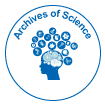Stem Cell-Based Regenerative Medicine: Current Progress and Future Directions
Received: 01-Mar-2025 / Manuscript No. science-25-168761 / Editor assigned: 03-Mar-2025 / PreQC No. science-25-168761(PQ) / Reviewed: 17-Mar-2025 / QC No. science-25-168761 / Revised: 22-Mar-2024 / Manuscript No. science-25-168761(R) / Published Date: 28-Mar-2025
Abstract
Stem cell-based regenerative medicine has revolutionized the way we approach tissue repair and disease treatment. With their unique ability to self-renew and differentiate into diverse cell types, stem cells offer unprecedented potential for restoring damaged tissues, treating chronic conditions, and even reversing degenerative diseases. This article delves into the science of stem cells, examines their clinical applications, reviews recent breakthroughs in tissue engineering and organ regeneration, and discusses the regulatory, ethical, and technical challenges facing the field. The future of regenerative medicine lies at the intersection of biotechnology, nanoscience, and personalized medicine, heralding a transformative era in healthcare.
Keywords
Stem cells; Regenerative medicine; Tissue engineering; Pluripotency; Cell therapy; Organ regeneration; iPSCs; Ethical challenges; Clinical trials; Biomedical engineering
Introduction
Regenerative medicine aims to restore or establish normal function by replacing, engineering, or regenerating human cells, tissues, or organs. Among the various tools in this field, stem cells have emerged as key players due to their unique ability to differentiate into multiple lineages and proliferate indefinitely under the right conditions [1]. These properties make them indispensable in developing cell-based therapies for a range of diseases, from neurodegenerative disorders to cardiovascular ailments and musculoskeletal injuries [2].
Stem cells can be classified as embryonic stem cells (ESCs), adult stem cells (ASCs), and induced pluripotent stem cells (iPSCs), each with its own scientific and ethical implications. While ESCs are derived from early-stage embryos and exhibit high pluripotency, their use is controversial. In contrast, iPSCs, reprogrammed from somatic cells to an embryonic-like state, offer a promising alternative with fewer ethical concerns [3].
Description
The therapeutic application of stem cells involves their isolation, expansion, and directed differentiation into specific cell types. This process is guided by a controlled culture environment and various biochemical and mechanical cues. Advances in 3D bioprinting, scaffolding technologies, and bioreactors have significantly enhanced the ability to engineer tissues ex vivo [4].
In clinical settings, stem cells are currently being used to treat hematologic malignancies through bone marrow transplants, and clinical trials are underway for treating diabetes, Parkinson’s disease, spinal cord injuries, and macular degeneration. Mesenchymal stem cells (MSCs), in particular, are under extensive investigation due to their immunomodulatory properties and ease of isolation from bone marrow, adipose tissue, and umbilical cord [5].
iPSCs, first introduced by Shinya Yamanaka in 2006, have added a new dimension to regenerative medicine. These cells not only bypass ethical constraints but also enable autologous transplantation, reducing the risk of immune rejection. Moreover, iPSCs are increasingly being used in disease modeling and drug discovery platforms, offering insights into patient-specific pathophysiology [6].
Results
Recent studies have demonstrated the successful regeneration of heart tissue post-myocardial infarction using cardiac progenitor cells derived from stem cells. Similarly, in ophthalmology, stem cell-derived retinal pigment epithelium (RPE) has restored partial vision in patients with age-related macular degeneration [7]. In orthopedics, bioengineered cartilage seeded with autologous stem cells has shown promise in treating joint degeneration.
In the laboratory, whole-organ engineering is gaining momentum. Researchers have bio-printed mini-livers and kidneys using stem cell-derived organoids, though their functionality and scalability remain under evaluation [8]. In neurological diseases, trials with neural stem cells in ALS and multiple sclerosis are revealing modest but encouraging outcomes, with observed improvements in motor functions and slowed disease progression [9].
However, despite this progress, challenges remain. Risks of tumorigenicity, genetic instability during culture, and variability in differentiation potential continue to hinder widespread clinical adoption. Furthermore, standardizing manufacturing protocols and ensuring long-term safety and efficacy remain critical hurdles [10].
Conclusion
Stem cell-based regenerative medicine is advancing rapidly, driven by breakthroughs in molecular biology, materials science, and biomedical engineering. From lab-grown organs to personalized cell therapies, the possibilities are vast. Yet, to move from promise to practice, the field must overcome significant scientific, regulatory, and ethical challenges. Ensuring rigorous clinical trials, long-term monitoring, and clear regulatory frameworks will be key to unlocking the full potential of stem cells in treating disease and restoring health. As interdisciplinary collaboration intensifies, regenerative medicine stands poised to become a cornerstone of 21st-century healthcare.
Citation: Carolina R (2025) Stem Cell-Based Regenerative Medicine: CurrentProgress and Future Directions. Arch Sci 9: 275.
Copyright: 穢 2025 Carolina R. This is an open-access article distributed underthe terms of the Creative Commons Attribution License, which permits unrestricteduse, distribution, and reproduction in any medium, provided the original author andsource are credited.
Select your language of interest to view the total content in your interested language
Share This Article
91勛圖 Journals
Article Usage
- Total views: 99
- [From(publication date): 0-0 - Aug 29, 2025]
- Breakdown by view type
- HTML page views: 70
- PDF downloads: 29
